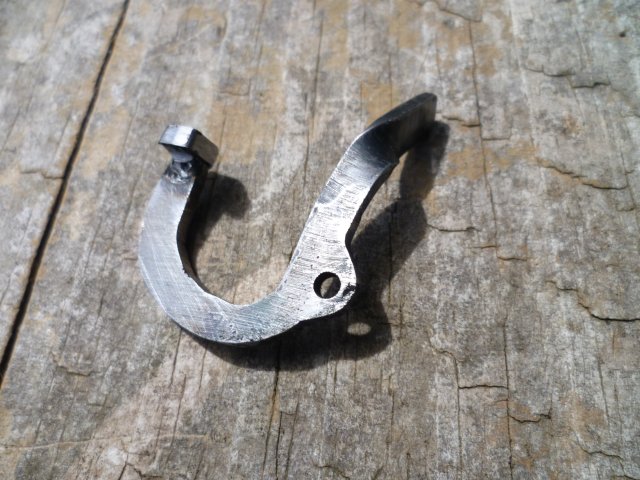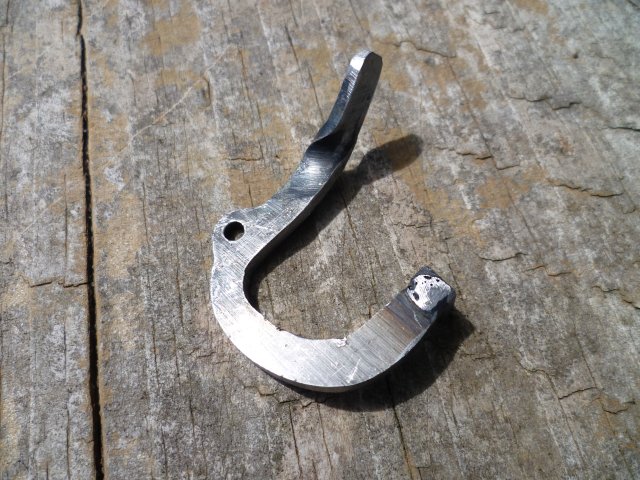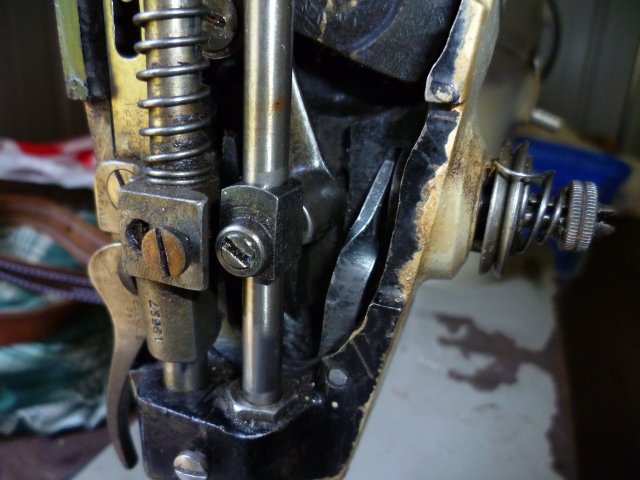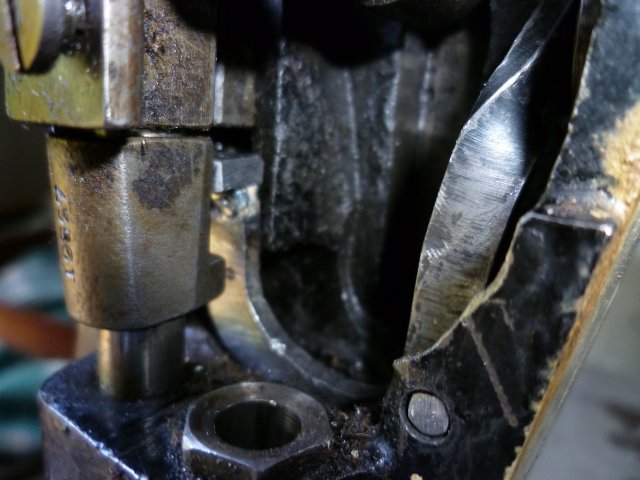-
Posts
4,801 -
Joined
-
Last visited
Content Type
Profiles
Forums
Events
Blogs
Gallery
Everything posted by dikman
-
See what you mean, not a lot of info turns up, but it looks like a nice little walking foot. They say light/medium/medium heavy glove leather so I would think it should handle the seat leather?
-
Madmax, I too thought that the single central support could be a little wobbly, unless it was made particularly thick! I have a spare set of legs from a table and was toying with the idea of using them to make a narrow version of a "standard" table. It wouldn't be quite as compact as the Cowboy table but should be more stable. Failing that, making one with four vertical posts, one in each corner, might be another option, although making something like that with adjustable height might be a bit of a problem.
-
Sorry mate, should have posted a picture. The only one I could find in a hurry is on this page - http://www.tolindsewmach.com/cowboy.html
-
The biggest problem with this machine (besides the horrible paintwork!) was the lack of a thread tension release. Going through the old parts lists I found what it was supposed to look like but didn't like my chances of being able to buy one - so I figured I'd make one. While obviously not as neat as the "bought" one, it works, which is the main thing. The shape is also slightly different as I'm assuming the genuine part is probably hardened, being so thin, but all I had to work with was plain steel so I put a twist in it to give it more strength where it pushes on the release pin. It took a lot of trial-and-error fitting and grinding to get it so it would just squeeze in without removing too much metal. I was going to paint it but then realised with all the oil in there it would probably dissolve the paint, so I just gave it a good coat of thick wax. It's not pretty, but I can't see it when it's inside!! It was a bit of a pain working in that area! Now for the paint........
-
I have a Pfaff 335 which is mounted on a conventional table, which makes it look like there's a lot of wasted space. I've been looking at some of the minimalist-type tables that the Cowboy-type cylinder arms etc use and wondered what are the pros and cons of using this type of table? It would certainly have a smaller footprint and would be practical to fit wheels to and make it somewhat moveable. Could be an interesting project. Do you folks who use these tables find they have any serious disadvantages?
-
You're doing well, Chayse. Now you've got to admit, isn't it a lot of fun fixing these things up?
-
Yep, I'm already noticing that . The straight stitchers aren't too bad, but those walking foot machines are getting heavier and heavier and heavier.....
-
Be careful, it doesn't always work like that. I had a blower for my forge that was a beautiful old Italian unit (was used for circulating air in old radio communication cabinets) and one day i turned it on and saw a couple of sparks come from it, but it still worked. Later I opened up the connection box to have a look and the lacquered covering on the winding wires had deteriorated but because they disappeared into the body of the motor it was impossible to repair. This is the other real danger with old motors, if the wiring that actually goes to the coils is moved it has a tendency to flake off the lacquer coating as this becomes extremely brittle with age and heat from the motor.
-
Nice puns, Mike . ndnchf, it's good that you understand what we're talking about re- the motor. Many people don't realise how potentially dangerous they are. I still have an old Singer clutch motor (first one I got, and mine's bigger than yours ). I'm reluctant to get rid of it because, like you and Constabulary, I reckon it's a wonderful old piece of machinery - but I'll never use it and don't really know what I'll do with it. At least yours has the braided covering on the wires so there's a good chance that the wiring is safe - for now - but I notice in the second photo that it has joiners on the ends of the wires that are wrapped in the old cloth "insulation" tape. That stuff is also not good. Having said that, as long as you don't touch or move the wires it might be ok - for a while.
-
First thing, motors that old can be dangerous once you start moving them around and/or messing with them. The wiring insulation was generally a rubber compound which, over time, becomes hard and brittle, and when it's moved the insulation breaks and falls off. The switch box may have a large capacitor in it (mine has) for starting the motor and these can also dry out and make the motor difficult to start. I recently bought a 111W117, which came with an old Singer motor (different to yours), I didn't hesitate in junking it. As for servicing, if it's been greased and still spins ok then the only other thing that might be an issue is if the clutch faces need cleaning. If yours is working ok then my advice is don't touch the motor! The servo is a no-brainer, particularly if you want to do leatherwork.
-
Short answer - yes! As mentioned a 441 or similar (or bigger) 'cos holsters will be the problem. With my assortment of machines I can do pretty well everything EXCEPT holsters , they're just too thick. For your wife, a cylinder arm would probably be more versatile, but a flat bed should cover her needs, any of the 111/211 variants or a Pfaff 335 or clone.
-

Singer thread tension slide - part #264527
dikman replied to dikman's topic in Leather Sewing Machines
Got one from the sewing place (part #240500, the number I first quoted is defunct). Naturally, it didn't quite line up and needed some judicious bending and re-shaping, but I now have a working tension release! Another functioning machine to add to my (growing) collection. Now for the 31K20..... -
Chayse, you beat me to it re- fishing rod guides. The old ones were extremely tough when it came to wear, just a little bit brittle! The modern versions are also tough but not brittle. When I built my own rods many years ago I uses Fuji guides which, of course, come in all sorts of sizes. Could be worth keeping in mind for anyone looking for a thread guide of some sort.
-

Commercial Singer Treadle (motorized) w/96-10 Head
dikman replied to suzelle's topic in Leather Sewing Machines
The missing part is the actual internal lever that operates the little push rod to release the tension (it's shaped like a fish-hook!). I'm in the process of making one. It's good that you can move things on, my problem is things come in but don't go out!!! -

Advice for Leather Sewing Machine for Handbag Business
dikman replied to swellmels's topic in Leather Sewing Machines
Hi Melissa, welcome to the forum. That is a post-bed machine with a roller wheel foot. A nice enough machine, but I would think a walking foot is going to be better for your leatherwork (you'll probably find it easier to control and more versatile). A cylinder arm, as you say, is a good starting point, with a servo motor which will be easier to learn to use. Being new to industrial machines, and wanting it for business use, contacting one of the vendors on here would be the smart thing to do. While suitable machines can often be picked up used they will probably require time and effort to sort out. If you talk to the vendors they will not only be able to recommend a suitable machine but you will have one that will work straight away and they will be able to provide advice if you get stuck. -

Commercial Singer Treadle (motorized) w/96-10 Head
dikman replied to suzelle's topic in Leather Sewing Machines
$1000 to paint a sewing machine??? I guess the sewing machine fixation runs strong in your family. I oiled the 31K20 and it spins real easy. Found a bobbin that fitted and handwheeled a few stitches in some leather, which looked reasonable (nothing that some adjusting won't fix) but it's snagging strands of the top thread, which could be the thread as it's some old stuff I got with one of the machines. I have a bigger problem, however, and it's the same as my other machine - no thread tension release!! In this case I found a photo of the missing part, but even in the parts list it's labelled as obsolete!!! Unless I can make a replacement the machine is of little use. If I can make one then I'll repaint it. While most of my other machines are in varying shades of grey and/or grey/silver this particular colour is obnoxious and is a sloppy job that has been applied rather thickly. Something to think about. -
Just keep in mind that some of the auto oilers require the machine to be run at high speed to work - usually much faster than we leathersewers like to use.
-

Commercial Singer Treadle (motorized) w/96-10 Head
dikman replied to suzelle's topic in Leather Sewing Machines
Looks like you're off to a good start if it's actually sewing! At least yours is the right colour and has the lettering on it. I had a quick look at the 31K20 that came with my treadle, and there's virtually no oil on the moving parts (but no rust either). I've decided to oil it up, fit a bobbin race and see if it sews. If it does then I'll strip the horrible grey paint off it and repaint it black. I don't need this machine but it just looks very sad in its present colour. -
Ok, I see what you're talking about. Yep, using a knee/foot lift will let you get thicker stuff under the feet but I think there would still be problems with the feet being able to feed the leather properly. Of course, I could be wrong here as I haven't experimented that much with it, I've learned to keep my machines pretty much within the range they were designed for (I don't need to create any more problems than necessary!!). Actually, I haven't used my 211 much as I've found that the 111WSV77 has a longer stitch length and seems able to punch through a bit better (although the 211 was a bit smoother to use).
-

"Hunter" knife and sheath
dikman replied to pzarkov's topic in Gun Holsters, Rifle Slings and Knife Sheathes
I'm not a fan of basketweave, but your stuff is very sharply defined! -

A Holster and belt
dikman replied to OLDNSLOW's topic in Gun Holsters, Rifle Slings and Knife Sheathes
Sorry, I guess being a Pom raised in Oz might account for the spelling mistake . (Maybe I was subconsciously thinking of the Purdy shotgun...). -
Jim, I think you'll find that on most machines (certainly all that I've come across) the foot-operated lift is always higher than the hand lever, otherwise you wouldn't be able to release the raised feet by using the foot pedal. I tweaked my 111 to try and get that extra clearance under the feet but it then meant that the feet didn't touch the feed dog on the down-stroke. This was ok as long as I used thick leather, but this also affected the clearance needed by the feet when moving back and forth. I didn't persevere with it.
-
I couldn't find a manual for this model, but found an earlier post about it - I assume you want to increase the lift height and clearance under the presser foot? If so, it can be done by tweaking the adjustments for the two feet, but it can take a bit of fiddling to get it right and the feet may not end up touching the feed dog plate. My experience with my 111's has been that it doesn't gain a lot by doing it, plus if you try to run leather through that is too thick for what the machine was designed for you may end up with other issues. The maximum stitch length is determined by the mechanical design of the particular machine. While theoretically it may be possible to change the stitch length by swapping out parts from another 111 model it's not something I would recommend trying - it's a big job, and not for the faint-hearted. Just enjoy the machine for what it is, the 111's are a wonderful, solid design.
-

Singer thread tension slide - part #264527
dikman replied to dikman's topic in Leather Sewing Machines
Lots of time on Google has come up with several part numbers for the same thing. Singer 264527 - fits my 117 and 153W103 Singer 240500 - fits 111W154/155 Consew/Seiko 10546 - 206B Juki B-1461-053-0A0 - Lu 562/563 Hopefully the industrial machine place in town can get one of them! -
Dorothy, it's obvious that you're starting from scratch regarding industrial machines (that was me a couple of years ago!) and there's a lot to learn. If you haven't done so already, read the stickies above (particularly Wiz's about leather machines) as it might help to understand the terminology a bit. I can only urge you to talk to Rocky, his kind offer to talk to you will save you a lot of time in coming to grips with this subject, and his experience would be hard to put a price on. In short, a clutch motor has always been the "standard" for industrial machines, they are fast (which is what's normally needed for commercial use) and can take a lot of practice to master. Most leatherworkers need the machine to go slow, which can be done with a clutch motor but requires a delicate touch (I couldn't do it!). A servo motor is an electronically controlled replacement motor that allows very slow speed control and requires very little time to learn to use. There is usually no one machine that can sew everything unfortunately. If a machine is designed for heavy (thick) leather it can be tricky to sew lighter stuff. If it can sew light to medium leather then it won't do heavy/thick stuff. This is why it's important to know exactly what it is you want to sew. Another "complication" is thread thickness. If you want to sew similar thread size to that used in hand stitching you need a big, heavy duty machine! You may have to change your ideas slightly about thread thickness if you want to use a machine for your work. The most commonly used thread sizes are #69/Metric 40 and #138/Metric 20. Once you start going bigger you need the bigger machines, plus the bigger threads can be hard to find here in Oz. It might seem a bit daunting at first but don't get discouraged, if you can determine which machine is going to fill your needs it will speed up your production significantly.






